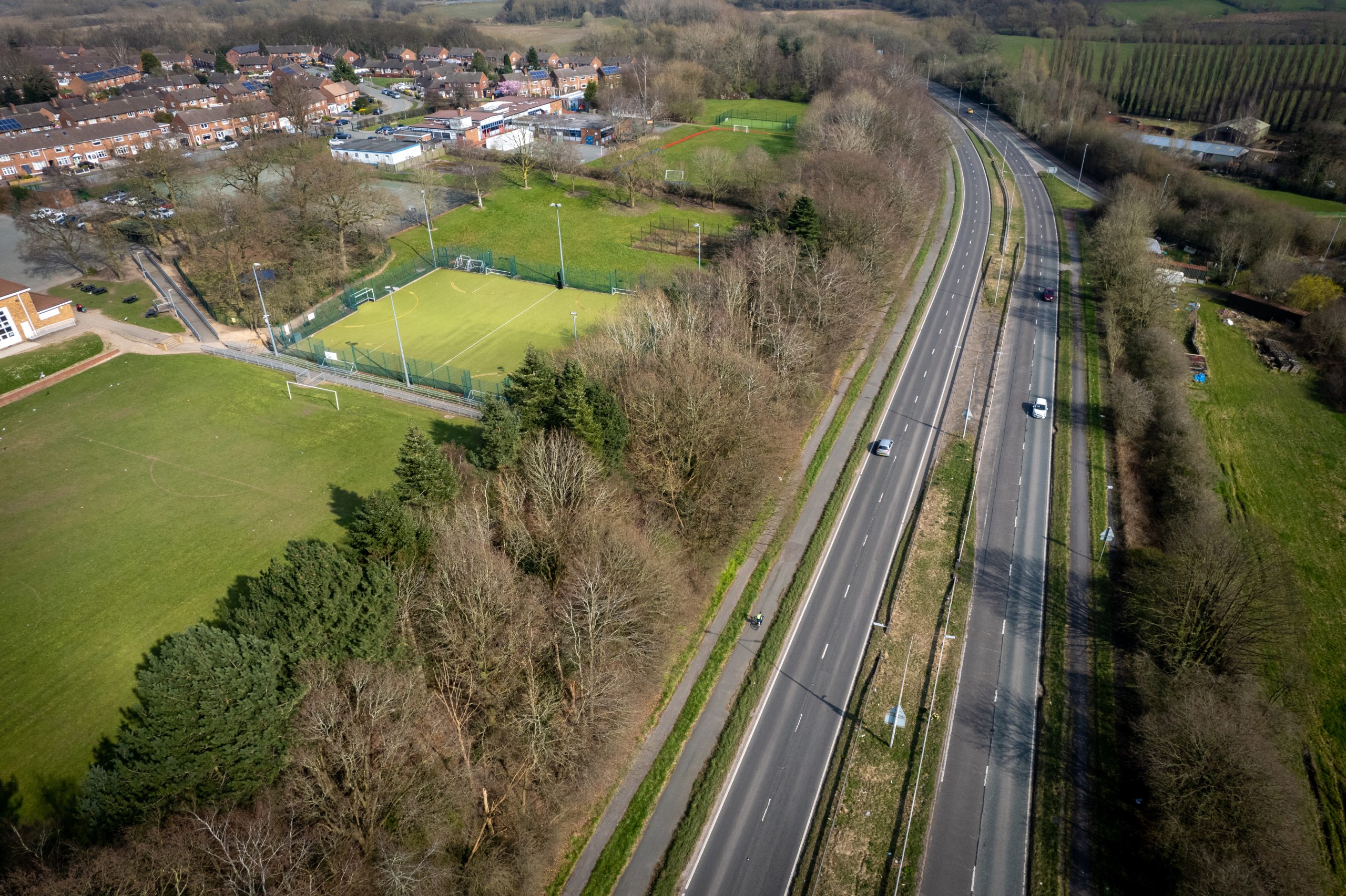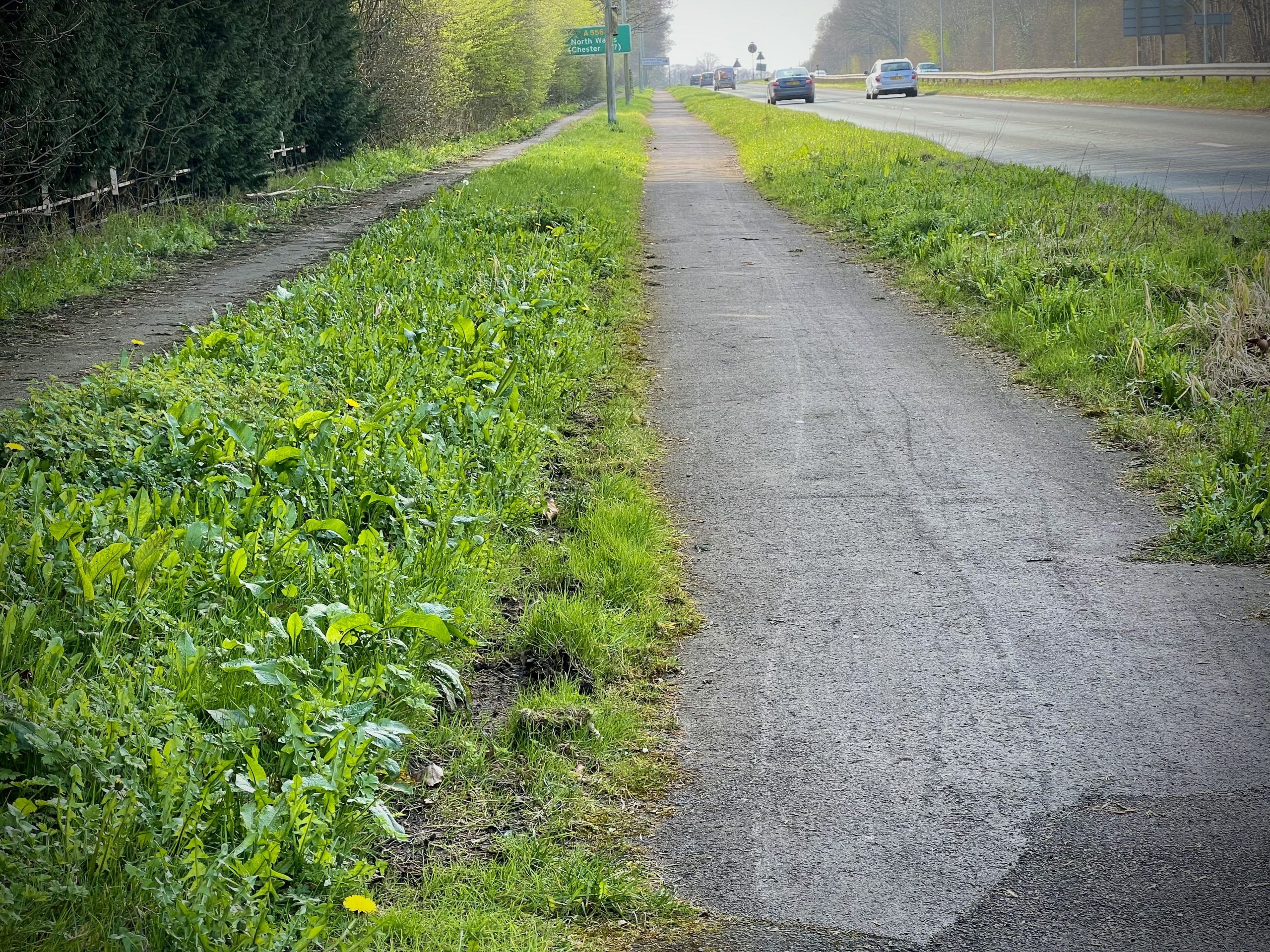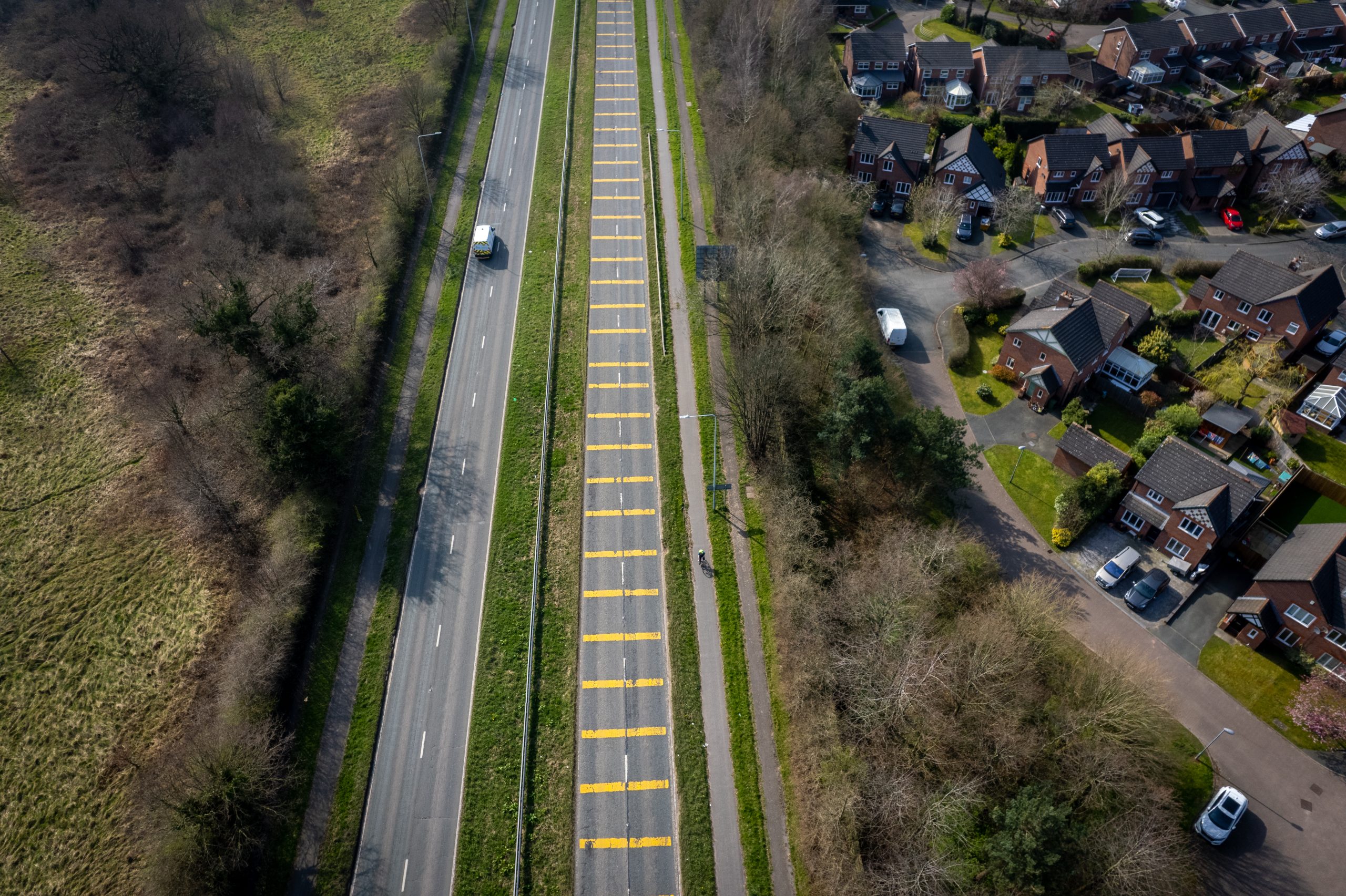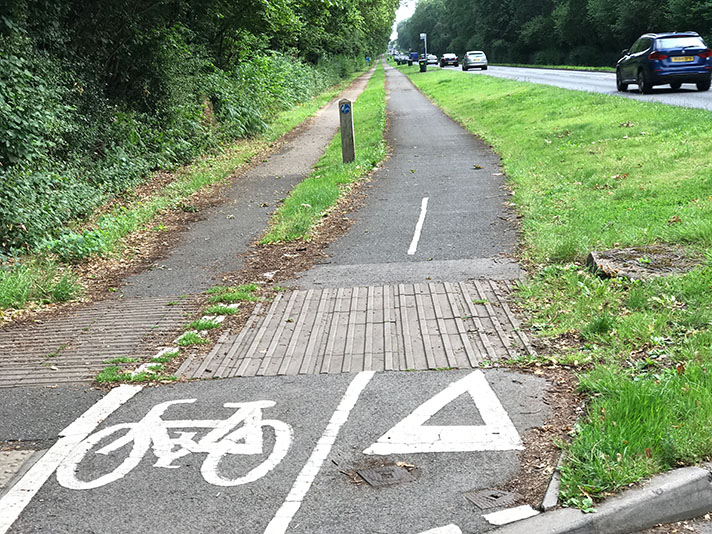
Footways and cycle tracks near Davenham.
Planned in 1930, then halted in 1935 after the Ministry of Transport demanded the inclusion of 9-ft-wide cycle tracks, the Northwich bypass — or, at least, a three-mile central section of it — was finally opened on 25 May 1939.
Land for the bypass had been sterilised for six miles from Sandiway Bank (to the south-west of Northwich) to Lostock Graham (to the north-east) but, as can be seen clearly on Google Earth’s 1945 aerial layer, the beginning and end of the bypass were not finished by the end of the war.
The full bypass was opened on 15 December 1958, but with high-quality cycle tracks only on the pre-war section.
Google Earth’s 1945 aerial layer shows the cycle tracks and footways clearly. They extend from School Lane, Hartford, to King Street, Broken Cross. Today they are overgrown in places but the cycle tracks and the footways are still in use. (A short section of the bypass at Leftwich is carried over today’s A533 by a modern flyover, with cycle tracks and footways, obliterated at ground level, recreated on the elevated dual carriageways.)
“The scheme for the construction of the Northwich by-pass road, which was proposed five years ago, and was estimated to cost £150,000, is threatened with serious delay,” worried the Cheshire Observer in April 1935.

Footway and cycle track beside the Northwich bypass.
A delay, continued the newspaper, caused by the Minister of Transport who “now asks that the road should be provided with two cycle tracks and footpaths.”
This was a “calamity,” griped Mr. J. A. Cowley, clerk to the Northwich Urban Council.
“If the Minister insisted on a dual carriage way with cycle tracks and footpaths, the cost would be increased from £50,000 per mile to £190,000 a mile,” pointed out Major Tomkinson, chairman of Cheshire County Council’s main roads committee in August 1935.
The council’s 1930 plan had called for a road of 60 feet with a single carriageway of 30 feet. The MoT’s revised plan demanded a 120 foot road, with cycle tracks.
“We have to consider,” said Major Tompkinson, “whether roads of this class are necessary, and whether we can afford them.”
After the MoT offered to pay 75 percent of the road’s construction budget the cost to the ratepayers of Cheshire for this £280,000 bypass dropped to only £12,000.
Still, the County Council complained but, in November 1935, the MoT insisted that “in view of the traffic which the new road was likely to carry, the importance of the route, of which it would form part, and the fact that it represents a substantial piece of new construction for approximately 6.5 miles, the Minister could not see his way to depart from the opinion that, in spite of the enhanced cost, it would be in the interests of public safety that the bypass should be equipped with dual carriageways and cycle tracks.”
By May 1936 the council had backed down, and work on the central section of the bypass began.
“The present proposal is to construct a length of three miles between Model Farm, Hartford, and Broken Cross, which will form a link between existing roads,” reported the Liverpool Echo.

Cyclist on cycle track beside the Northwich bypass, near Davenham.
“Each of the dual carriageways will be 22ft. wide,” said the newspaper. “The cycle track will be 9ft. and the footpaths 6ft. wide.”
“It expected that the work on the middle section of the by-pass will be completed by the end of 1938,” estimated the newspaper, which was only out by five months.
An MoT letter to the American Embassy in London in March 1937 said the cycle track was made from “precast cement and concrete edgings.”
During the war, one local, a child at the time, remembers the bypass being used to store tanks, a common role for these roads, and which led to a great deal of damage.
In June 1939, just a month after the bypass opened, a motorist shouted at cyclists riding on the carriageway telling them to ride on the track provided for them.
Neville Percy Alexander, a 21-year-old from Stockport, was fined at Northwich Police Court for driving his car in Rudheath without reasonable consideration for other road users.
“Evidence was given that Alexander cut in front of cyclists on the new Northwich by-pass and shouted to them to get on to the cycle track,” reported the Manchester Evening News.
“Fred Collins [of Pendlebury], one of the cyclists, said they were using the carriage way because there were a lot of pedestrians on the cycle track,” continued the report.
In a letter to the court, Alexander stated that as he passed the cyclists he slowed down and “told them to get on the cycle track.” He complained that “they shouted back derisively.”
While Collins and his cycling chums didn’t use the cycle track there are several period reports of other people on bicycles doing so.
A collision between two cyclists on the tracks close to Hartford Bridge was described at Northwich Petty Sessions, reported a newspaper in 1944.
Runcorn tannery worker Mark Rose was accused of riding a bicycle negligently causing hurt and damage to Doris Lowe on 24 June.
“Inspector A. Hughes said that Miss Lowe was cycling along the By-Pass on the special track towards the bridge when defendant, also on a bicycle, suddenly turned into the cycle track from the main carriageway in front of Miss Lowe, causing her to fall off her machine,” reported the Winsford Chronicle.
Four years later, a Davenham draughtsman was caught carrying a plank of wood while riding on the bypass track. Despite being “a man of good character and of some responsibility at his work,” magistrates fined Arthur Kennet Davies for theft. His excuse had been he was only carrying the 12-foot length of timber to prove that he had ridden into it.
“He ran on to the cycle track on the by-pass road, where there was little traffic, so that be could safely lean over and test the dynamo [light] connections as he rode along,” his defence claimed.
“When I was approaching the island, this post, lying across the track, diverted my front wheel, the cycle hit the kerb and I came off,” said Davies.
“I had the idea of taking the plank home and ringing up the District Surveyor to ask him who was responsible and to ask him to send someone to collect it,” continued Davies, who was stopped by a policeman.
“I had no intention of stealing the plank,” Davies pleaded, to no avail.
Eleven years later — and a year after the full bypass opened — a road safety officer fretted that a “stranger might think the cycle track ran for the whole of the length of the by-pass.”
The cycle track didn’t quite reach the entrance to School Lane in Hartford said Mr. H. S. Smith, a member of Mid-Cheshire road safety committee, adding that “there will be death on this road” unless improvements were made at the junction with the bypass.
“The cycle track ends before drawing level with the entrance to School-lane and it is therefore necessary for children to proceed along the carriageway for a short distance and then make the right-handed turn across the Manchester-directed traffic line,” complained Smith.
Agreeing, Mr. D. N. Marshall, the Mid-Cheshire road safety officer, said it would improve matters if the cycle track was extended to end directly opposite the entrance to School Lane. Google Street View shows that it does; remedial work must have therefore been carried out on the junction some time after April 1959.
Google Street View also shows that school children and cyclists still use the cycle track and footway at the School Lane junction. However, there are only narrow, footway-style paths on the post-war ends of the bypass.
The period cycle tracks and footways on the central section of the bypass need some TLC but they continue to perform as excellent links for those living, working and studying in Rudheath, Leftwich, Davenham, Kingsmead and Hartford; much of the housing in these outer suburbs of Northwich grew up after the creation of the bypass.







